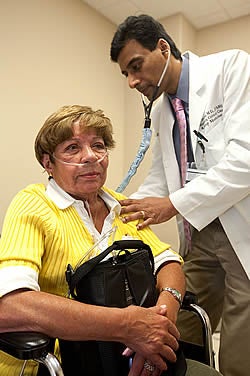New clinic offers better care for pulmonary hypertension
People in eastern North Carolina with the deadly disease pulmonary hypertension now have a one-stop clinic where physicians are providing coordinated, convenient care.
East Carolina University has reorganized its pulmonary hypertension service so that patients can see lung and heart specialists in one visit in one place rather than having multiple visits.

Dr. Sunil Sharma examines Beatriz Ramirez in the new ECU pulmonary hypertension clinic. Photo by Cliff Hollis
Dr. Sunil Sharma, a pulmonologist and medical director of the clinic, said patients in the past typically would see a lung specialist, go home and a few days later get an appointment with a heart specialist. A week or two after that, the two physicians would communicate about the patient and devise a treatment plan, then inform the patient of that plan.
“Imagine that,” Sharma said Wednesday. “It was a piecemeal type of care.”
Now at ECU, he said, pulmonologists, cardiologists and cardiothoracic surgeons are “deciding under one roof, in one visit, what’s going to be your diagnosis and what’s going to be your treatment. The patient doesn’t have to move. That era is gone. The patient leaves this room with a plan.”
That approach carries great benefits for people with a disease where the median lifespan after diagnosis is three years, according to the Centers for Disease Control and Prevention. While the disease was once viewed as untreatable, medical advances have made it so speedy, coordinated care and medicine management can improve the quality of life and length of survival, Sharma said.
Sharma said that although the name of the disease doesn’t sound so bad, its effects are deadly serious.
Pulmonary hypertension is high blood pressure in the small and medium-sized blood vessels in the lungs caused by a stiffness of the arteries. These arteries carry blood from the heart to the lungs to pick up oxygen. Pulmonary hypertension causes symptoms such as shortness of breath during routine activity such as climbing two flights of stairs, tiredness, chest pain and a racing heartbeat.
As the disease worsens, its symptoms might limit all physical activity, according to the National Heart, Lung and Blood Institute.
The strain pulmonary hypertension puts on the heart can lead to congestive heart failure, the most common cause of death in people who have pulmonary hypertension. In 2002, more than 15,600 people died from it, and 260,000 people were hospitalized for treatment, according to the CDC.
Sharma said the leading cause of pulmonary hypertension is rheumatoid arthritis and other connective tissue diseases, which damage the arteries. Other causes include certain birth defects, certain diet medications, HIV infection and obstructive sleep apnea.
Dr. Paul Bolin, chair of internal medicine at the Brody School of Medicine at ECU, said the pulmonary hypertension clinic is the first of four multidisciplinary subspecialty clinics his department plans, where different doctors will focus on one disease.
“This collaboration is really something the whole school should look at and it should be a model for eastern North Carolina,” he said.
The clinic sees patients at Moye Medical Center at 521 Moye Blvd. For more information or to schedule an appointment, call 252-744-4653.